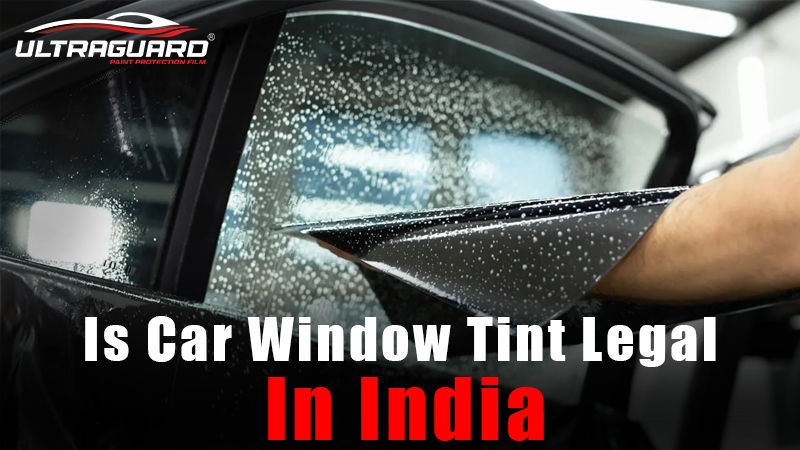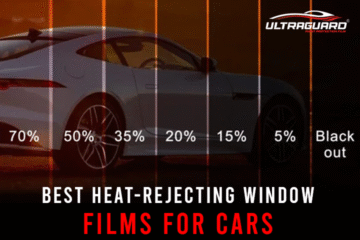When it comes to protecting your car’s interior from unexpected harsh UV rays from the sun, the control of privacy and basic driving comfort, car window tint or sun control films appear as a demand solution among car owners. The window tint for cars is not just about the look; It includes several essential purposes, such as reducing dazzling, protecting passengers from harmful UV rays, and even improving fuel efficiency by reducing the load on air conditioning. In the hot areas of India, especially in the high summer months, car window films can be a lifesaver for thermal comfort. However, as much as they are valued for the benefits, they also raise the question Is car window tint legal in India?
Unfortunately, the answer is a simple yes or no. The validity of car window tinting laws in India has seen many changes over the years, driven by legal rules, traffic legislation, and concern for public security. As a result, the average car owner is often confused about what is allowed and what is not. In this blog, we can discuss the current legal status, historical background of the law, security implications, variation in enforcement in different states, and sun films in India.

Understand car window Tint Film
The car window film is a thin, multi-layer polyester material applied to the glass surfaces of a vehicle. It can be installed on either the inner or the outside of the glass and meets different dimensions:
Blocking UV rays:
Safeguarding humans from skin damage and averting interior damage.
Lessen dazzling:
It helps to prevent the dazzling effect, especially when driving in bright sunlight or using headlights at night.
Makes the interior cool:
Lessening the heat assists in keeping the car’s interior cool, making it a more comfortable and enjoyable ride.
Increasing privacy:
It won’t be easy to see inside the vehicle.
Prevention of the glass from shattering:
an effect that prevents the glass from spreading during an accident.
Although these benefits make window tint very desirable, dark-coloured variants have been the centre of many legal and security debates in India, mainly because they limit external visibility in the vehicle.
The Legal Foundation of Car Window Tinting Laws in India
Central Motor Vehicles Rules (CMVR), 1989
According to Rule 100 in Central Motor Vehicles Rules (CMVR), 1989, the window tinting rules in India are set by the Indian government for the vehicle’s visibility criteria. This rule determines the minimum allowed visible light transfer (VLT) for different vehicle windows:
1. Front Windshield: Minimum 70% VLT
2. Rear windshield: Minimum 70% VLT
3. Side windows: Minimum 50% VLT
What is VLT?
VLT stands for visible light transfer, the percentage of light allowed to pass through glass. For example, a glass with 70% VLT allows 70% of visible light to pass and blocks the remaining 30%.
Here is the catch: The rules focus on 100 glasses and not aftermarket films. This determines the minimum level of visibility standard but does not directly stop or permit the installation of the sun film, even if the window tint film adheres to VLT limits when merged with the glasses. These errors contributed to confusion and conflicting interpretations until a Supreme Court decision provided clarity.
The Supreme Court Banned Tinted Films in 2012
In April 2012, the Supreme Court in India issued a judgment that dramatically changed the circumstances. In response to the concerns raised in the court dispute, the court banned all types of solar control films, even though they comply with VLT criteria.
What did the court say?
The court’s order was clear:
“No black film or other material can be glued to any vehicle’s windshield or side glass.”
The decision came amid increasing concern about crimes behind the windows of heavily tinted cars, but the intent was also to:
1. Increase public safety by making the vehicle interiors more visible.
2. Allow better monitoring of law enforcement.
3. Prevent abuse of tinted glass for illegal or criminal business.
Impact on car owners
The decision created shock waves among vehicle owners, especially in extremely hot states. While the intention was public safety, light or transparent films that helped reduce the heat or dazzling effects became illegal. The car owners invested in high-quality, expensive sun films, but they had to remove them, causing financial loss and disadvantage.
Current legal status (by 2025)
Below, you will see a few pointers on contemporary legal status.
1. The Supreme Court’s decision from 2012 is still legally binding and has been actively implemented in most parts of the country. Therefore, under current law:
2. Regardless of the VLT compliance, any aftermarket application of sun control film is considered illegal.
3. Only factory-fit glass with certified VLT levels is allowed.
4. Traffic enforcement has the right to order the immediate removal of fine violators and to order the instant removal of the films.
The decision has essentially closed the door for the use of solar films after they are on the market, creating a unique landscape. No matter how adhering to the laws, those products cannot be used if they are not pre-installed by the car manufacturer.
Penalty for the use of coloured films, violation of Rule 100, and Supreme Court bans can lead to the following penalties according to the Motor Vehicles Act:
- For the first time, a fine of ₹100 to ₹ 500 for criminals
- The vehicle growth or vehicle growth
- The traffic police would remove the sun on the spot. Enforcement drives are regularly carried out in many centres.
- Enforcement officers often use VLT meters to measure compliance and respond accordingly.
Are there any exceptions? While the rules apply to the public, there are some exceptions:
VIP and security personnel
Government officials may be allowed to use dark-coloured films under high-risk safety categories, such as Z+, Z, or Y. However, this requires written permission from local law enforcement authorities and is strictly regulated.
Emergency vehicle
Vehicles that carry patients with light sensitivity, ambulances, or mobile ICUs may be allowed to use tinted films for medical reasons. However, such exceptions are rare and not generalised.
Ordinary private vehicles are not allowed under exceptional circumstances.
Kerala High Court Twist (2021)
In 2021, the Kerala Supreme Court challenged the rule to the Supreme Court in a fine judgment. The court said that if a sun control film maintains legal VLT levels, it should not be considered illegal.
Does that change the law?
No, while deciding the debate and emphasising the need for clarity, the High Court’s decisions don’t overrule the Supreme Court’s decisions. The national legal status remains unchanged. However, the verdict attracted attention to the rigour of the current regulation and called for re-evaluation.
State Enforcement
The level of enforcement varies from state to city to city. This is usually the case:
Strict enforcement area:
- Delhi: Constant VLT – Measure, Check, and Fine
- Mumbai: Regular traffic campaign against tinted windows
- Bangalore, Hyderabad: High match due to active enforcement
- Mysuru: Recently launched a dedicated anti-tint campaign
Relaxation or Incompatible Enforcement
Small towns and rural areas often show lax enforcement
Light-painted films can still be used in areas with low traffic supervision.
Factory Fitted Tints
These are entirely legal. Most modern cars now come with predetermined windows that offer UV security, which meet all legal norms and do not attract punishment.
Why are the films that are still popular despite the risk of punishment? Many vehicle owners continue to install tinted films due to compelling benefits:
Extreme summer:
Areas such as Rajasthan and Gujarat face a burning summer. Movies significantly reduce inner temperatures.
Fuel efficiency:
A Cooler cabin means that air conditioning uses are reduced, leading to better fuel economy.
UV and skin protection:
Films block 99% of UV rays, protecting travellers.
Protect interiors:
Dashboard and upholstery can be minimised due to heat.
Safe Option
If you still want to protect the vehicle and comfort without breaking the law, there are some safe options here:
1. UV-blocking transparent films
High-end, transparent films that block UV and infrared radiation while maintaining more than 70% VLT. These are expensive, but if they are pre-created by producers, there are legal restrictions.
Detachable curtains/ sunshades:
The law allows for use when the vehicle is stabilised or parked, but using them while driving can lead to punishment.
2. Factory UV glass
Many premium and middle-segment cars now offer factory-installed UV-resistant glasses that comply with all rules.
As the future has many stakeholders, it is essential to look at the track in 2012, when climate change is rising and vehicle heat stress becomes a serious problem.
3. Possible improvement
Certified introduction to VLT-compliant aftermarket films
Standardised tools for enforcement managers to measure VLT accurately
The updated CMVR provisions provide the regulated use of transparent heat-rejection films.
Following the factory norms until this happens is a legally safe alternative for Indian motorists.
Conclusion
While car window films provide specific comfort and security benefits, their use in India is closely regulated due to the Supreme Court ban in 2012. As stated in 2025, any aftermarket application of the car window tinting laws in India, regardless of VLT adherence. Only manufacturer-fitted solutions that meet CMVR rules are allowed.
The safest passage is to live with legal options and wait for the regulator’s update. At the same time, consciousness, compliance, and a push for practical reforms can lead to a more balanced, healthy, and flexible future for Indian roads. You can also give your car complete protection with paint protection film, which safeguards your vehicle from bird droppings, stone chips, chemical stains, and many other environmental issues. By this, it increases the life of your car and also protects its resale value.
FAQS
Q1. Breaking car window tinting laws in India is ok?
No, aftermarket car window tints installation, no matter how light or transparent, will be illegal in India by 2025. According to the Supreme Court’s 2012 judgment, only factory-fit glass with compliance VLT (visible light transmission) levels is allowed.
Q2. What is the legal VLT limit for car windows in India?
According to Rule 100 in Central Motor Vehicles Rules (CMVR), 1989:
- Front Windshield: Minimum 70% VLT
- Rear windshield: Minimum 70% VLT
- Side window: Minimum 50% VLT
However, no aftermarket film is allowed, even if it meets these VLT requirements.
Q3. Why is there a ban on sun films in India?
The Supreme Court in 2012 banned Sun Control Films:
Traffic safety improvement
- Stop crimes behind dark-coloured windows.
- Help law enforcement’s visibility in vehicles.
The prohibition applies to all vehicles except persons with special state permits.
Q4. Is car window tint legal in India?
No, car window color is not legal in India if used as an aftermarket film, even though it is within the prescribed VLT (visible light transfer) boundaries. According to the Supreme Court’s decision from 2012, any sun control film, tinted film, or dark film stuck on the vehicle’s windows, regardless of its transparency, is considered to be breaking the law.
Only factory-fit tinted glass that complies with Rule 100 in the Central Motor Vehicle Rules (CMVR), 1989, is allowed.
Q5. Are there any exceptions to the car window tinting laws in India?
Yes, but only for:
VIPs and individuals under the Z+ or Z category, Safety coverage
Emergency vehicles under specific medical requirements (e.g., ambulance)
They require special permits and do not apply to the public.
Q6. What is the penalty for violating car window tinting laws in India?
If the illegal window was caught using the films:
For the first crime, you can be fined ₹100 to ₹ 500
Frequent violations can lead to increased fines or vehicle seizure.
Police can also remove the film on-site.




0 Comments